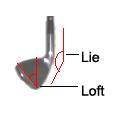Club loft
The loft describes the angle of inclination of the face of a golf club relative to a vertical face. It is measured with a plumb line and expressed in degrees . The loft of a club determines the height of the trajectory of the ball and thus the distance. The larger the angle, the higher the trajectory and the smaller the distance of the shot.
The lie describes the angle of inclination of the shaft of a golf club to the sole of the club head. The longer the shaft, the smaller the lie to bring the sole horizontally to the ground. Of course, the player's size and swing also play a role here. Therefore, the correct lie is checked or adjusted for the player and his swing path as part of a racket fitting .
There is no industry standard for the loft that prescribes certain degrees, so the club manufacturers come up with different systems. Club sets for beginners often have higher lofts than those for better players, and there are occasional differences between men's and women's clubs.
Example of an average set of clubs
- Wood 1: 8.0 ° - 12 ° (also called driver )
- Wood 3: 15 °
- Wood 5: 19 °
- 4 iron: 24 °
- Iron 5: 27 °
- 6 iron: 31 °
- Iron 7: 35 °
- Iron 8: 39 °
- Iron 9: 44 °
- Pitching wedge: 46 ° -48 °
- Gap Wedge: 50 ° -52
- Sand Wedge : 54 ° -56 °
- Lob Wedge : 58 ° -60 °
- Putter : 3 ° -4 °
More rackets
- Iron 1: 15 ° (is practically no longer produced or played today)
- Iron 2: 18 ° (uncommon today, mostly replaced by wood 5 or wood 7 or hybrid)
- Iron 3: 21 ° (only used by good players today)
- Wood 7: 22 ° (replaces iron 3, there is also wood 9, wood 11 etc. with a loft that increases by approx. 4 °)
- Hybrid : wide range for lofts, from about 14 ° to 34 ° or more. Almost all woods and irons can thus be replaced by a corresponding hybrid.
